Post-presidency of George Washington
| Post-presidency of George Washington | |
|---|---|
 | |
| President of the United States | |
|
In office April 30, 1789[lower-alpha 1] – March 4, 1797 | |
| Personal details | |
| Born |
February 22, 1732 Popes Creek, Colony of Virginia, British America |
| Died |
December 14, 1799 (aged 67) Mount Vernon, Virginia, U.S. |
| Cause of death | Epiglottitis and hypovolemic shock |
| Resting place | Washington Family Tomb, Mount Vernon, Virginia, U.S. |
| Spouse(s) | [1] |
When George Washington retired from the United States presidency in 1797, after his second term ended on March 4, he wanted to return home to Virginia as quickly as possible.[2] He rented a ship to transfer his goods to Mount Vernon and got rid of his disposable possessions. When Washington arrived at Mount Vernon on March 15, he said that he would experience "more enjoyment than in all the business with which I have been occupied for upwards of forty years." Mount Vernon, his beloved home on the bluffs of the Potomac, was in ruins, by mismanagement, and he began many months of repair work. Washington was able to restore the mansion house to its former glory, but he found reconversion of his farms to be problematic, even up until his death. Washington had many debts, and he sold his lands to pay for them.[2] In July 1799 he estimated that his unsold lands were worth $488,137 (or several millions in today's market). At a time when Presidents had no federal retirement, Washington needed large outside income. Throughout his retirement Washington entertained local friends, former official associates, and strangers who wished to converse and see America's first president, the Revolutionary War hero, and founder of the nation.[2]
Washington followed closely the affairs of state, including the growing tension between France and the United States, that by the Spring of 1798, developed into a Quasi-War. President John Adams on July 2, 1798 appointed Washington Lieutenant General and Commander of America's newly augmented army. Washington insisted that active command be vested in Alexander Hamilton, whom Adam's appointed Major General and Inspector of the Armies.[2] Washington performed his duties but Adams was jealous of Hamilton, and was a proponent of naval power rather than military preparedness. Adams, however, was able through diplomacy to end the Franco-American War. [3] Lieutenant General Washington kept a regimented routine at Mount Vernon and in the summer of 1799 he drafted a new will, that left most of his estate to his wife Martha, but unexpectedly, set free all of the slaves which he owned outright, a legal order to be fulfilled after his wife's death.[3] Washington's will was meant to be an act of atonement for a lifetime spent in human exploitation, while he hoped it would serve as an example to other slave holders, and hasten the end of American slavery.[4] His post-presidency lasted 2 years, 9 months, and 11 days until his sudden illness and death in December 1799. Martha chose to free Washington's slaves in January 1801, fearing that her life was not safe in their hands because her death would make them free.[5]
After his death 1799, Congress had promised to make a marble memorial for Washington in Washington D.C., however, Congress did not honor this pledge until 1876. Washington's first memorial was created in Maryland in 1827. In 1831, Washington's cousin Major Lawrence Lewis built a new vault, that Washington had requested 31 years earlier. Washington's body was finally interred in a marble sarcophagus in 1837. After a public out cry, the Washington National Monument Society was formed in 1833, and began a private building of the Washington Monument. The project was abandoned in 1854 due to lack of funding. During the nation's centennial, Congress, under President Ulysses S. Grant, took over the funding and building of the Washington Monument, that was completed in 1884, and formerly dedicated in 1885.
18th century
Return to Mount Vernon 1797
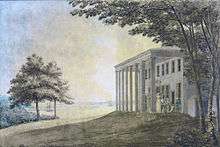
When Washington left office in 1797, the nation was divided into a two party system, the Republicans and the Federalists, who controlled much of Congress. The dispute with France over Washington's alliance with Great Britain in the Jay Treaty, had not been settled, and the country was on the verge of a Quasi-War. Except for strong political criticism from the Republicans, the public figure of Washington, however, was a legend as a General and the First President of the United States. Washington attended his successors John Adams Presidential Inauguration on March 4, in Philadelphia, and read aloud his final brief "farewell address", eager to return to his beloved home of Mount Vernon, after serving two consecutive terms of office.[6] Before his departure Washington sold and gave away his belongings, including a writing desk that contained love letters from his wife Martha. [7][8] Washington departed Philadelphia on March 9, traveling with Martha, his granddaughter Nelly, and George Washington Lafayette. The party arrived Mount Vernon "six days" later, having made a few stops along the way, as Washington was a celebrated hero. Upon his return Washington found his five farms and buildings at Mount Vernon were in ruins. He diligently put to work carpenters to fix the buildings, including the mansion house, while he made efforts to rehabilitate his farm lands. Washington's sister, Betty Lewis, died, and Washington was survived only by his younger brother Charles. Guests clamored to see the legendary General and his wife at Mount Vernon. Washington collected vast paper archives on the Revolutionary War at Mount Vernon, in what would turn out to be a precursor for a "presidential library".[9]
Hostilities with France 1797-1799
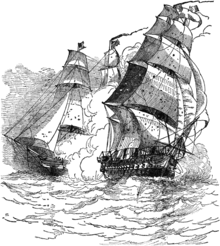
When Washington began his presidency in April 1789, France had been a strong ally with the United States, while Louis VXI strongly supported, financially and militarily, American independence from England, during the American Revolutionary War. Six days into his first term, the French Revolution plunged Europe into war, between France and England, while President Washington and his administration, chose to remain neutral. On January 21, 1793, Louis XVI was executed by guillotine. Matters became more complicated when Washington signed the Jay Treaty in 1794, during his second term, that gave an alliance to Britain rather than France. Starting in 1795, the French responded by capturing over 2,000 American merchant ships, while the American navy retaliated, attacked and captured, French naval ships.[10] French relations were broken when Washington left office in 1797, as the French embassy closed down, only a few days before President John Adams took office.
Upon assuming office, President Adams had to repair the damage caused by Washington's "shattered neutrality policy." [10] Preparation for war between the United States and France took place in 1798 after the XYZ Affair.[11] On July 2, 1798 Adams appointed Washington to Lieutenant General and Commander of the Provisional American Army, however controversy ensued in choosing Washington's subordinate Generals. On July 11, 1798 Secretary of State James McHenry, who personally traveled to Mount Vernon, presented Washington with letter and commission, already approved by Congress, from President Adams. [12] Washington accepted the commission but demanded he would not actively serve, unless the French invaded the United States. A terrible controversy ensued over Washington's suggested appointments for his subordinate generals. Adams, who both respected and was jealous of Washington's military prowess, reluctantly agreed.[13] Washington chose his former Treasury Secretary Alexander Hamilton, who was recommended to Adams by Washington to be appointed Major General and Inspector General of the Army, while Henry Knox and Charles Cotesworth Pinckney were to serve as Major Generals.[3] Knox, who desired Hamilton's position, protested to Adams, who contemplated the change. When McHenry and Adam's Secretary of Treasury Oliver Wolcott protested Knox as second in command, Adams demurred to Washington and appointed Hamilton instead of Knox, who refused to take his commission as Major General. Washington remained at Mount Vernon, while Adams started negotiations with France. Although Washington would not live to the war's end, the crisis was resolved in 1800, through Adam's diplomacy.[3]
Abolition-freedom new will 1799

Since the Revolutionary War, Washington was troubled by slavery, and had for sometime been contemplating freeing his slaves and reducing the size of his plantation. Washington knew that posterity, or future generations, would judge him harshly for his ownership of slaves.[14] He initially planned to sell lands, free his slaves, and use the money from the sale of lands to support his slaves, however, he could not find any buyers. Sometime during the summer of 1799, Washington had a frightening dream, where he and his wife were sitting on their portico when an angel came down from heaven and whispered in Martha's ear. Immediately Martha turned pale, disappeared, and then Washington woke up. Afterwards Washington took this as an omen of his immediate death, and he took upon himself to make a new will, that would solve his dilemma over slavery once and for all.[8][4][15]
Washington's new will stipulated that all the 124 slaves he owned at the time of his death would be freed, conditioned upon the death of his wife Martha. Washington was concerned over the effects of splitting slave families, and on his wife Martha's financial status, so he delayed his slaves freedom. The will stipulated that both the young and old would be cared for. The young freedmen would be brought up in a trade, while the elder freedmen would live off an annuity provided by Washington's estate. Washington was well aware how divisive his abolition will would be in slave holding Virginia, so he demanded that his slaves would not be sold or forced to leave Virginia after their freedom. In this sense, Washington intention may have been for blacks and whites to live together in the Virginia commonwealth as equal citizens, rather than be deported to Africa or recolonized.[15] Washington's elderly valet-shoemaker slave William Lee was freed outright for his “faithful services during the Revolutionary War.”[15] Washington gave Lee a $30 annuity.[16]
Historian John Ferling believed that Washington's will was an act of atonement for the life time he spent in human exploitation.[4] Additionally, Washington hoped that his example would lead other slave owners to take a similar step.[4] After Washington's death, Martha feared Washington's slaves were planning to kill her to obtain their freedom, since Washington's will stipulated their freedom was contingent upon her death. To prevent this, although it was unlikely his slaves would have killed her, Martha manumitted all of Washington's slaves on January 1, 1801. [5][15] Washington nor his wife Martha could free any of the Custis slaves by law. These slaves would be reverted to the Custis estate, upon Martha's death, and divided among her grandchildren. [17] Washington's will and manumission (freedom) of his slaves had a reverse affect on Virginia society, who in 1806, made more restrictive measures for slave owners to free their slaves.
Final days and death- December 1799
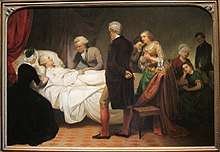
Junius Brutus Stearns 1799
Throughout his remaining days Washington kept a regular routine which included writing uniformly noted weather changes in his diary. On December 12, 1799 Washington rode a horse over the Mount Vernon acreage surveying the property in cold inclement weather. The following day, December 13, he rode out again, to mark trees to be pruned, and recorded that the temperature had dropped and there was frost. The following day, at 3:00 AM on December 14, Washington woke up and was acutely ill, with his speaking voice barely audible and having extreme difficulty breathing.[18] Dr. James Craik, Washington's personal physician plus two other doctors, Dr. Gustavus Brown and Dr. Elisha Dick, were sent for. Washington's condition rapidly worsened while his doctors purged, or bled him, and administered various standard medical procedures of the time period, all having no positive affect to help their dying patient.[19] Dr. Dick was strongly against Washington's fourth and final purge, because it would seriously weaken Washington, whose skin color had turned blue, a condition of oxygen deprivation. Seeing the gravity of the situation, Dr. Dick, the youngest of the three consulting doctors, recommended a tracheotomy to allow air into Washington's lungs, and save their patient's life, but the two senior physicians refused to have the fairly-new surgical procedure performed[20] Towards midnight, unable to breathe, Washington died. The two senior physicians diagnosed Washington's fatal illness as quinsey or cynanche tracheal while Dick thought that the condition was a more serious "violent inflammation of the throat".[21] More recent scholarship has concluded that Washington most probably died of acute bacterial epiglottitis.[19]
Mount Vernon military funeral 1799

Following instructions in his will, Washington's military funeral took place on December 18, 1799 at Mount Vernon restricted to family, friends, and associates, rather than a grandiose state funeral.[22] The funeral started at 3:00 PM, when a schooner moored in the Potomac began firing its guns every minute.[22] Inscriptions on the silver-plate of Washington's coffin included "Surge Ad Judicium", meaning rise to judgement, and "Gloria Deo" meaning glory to God. Military officers and fellow masons served as pallbearers. A musical band from Alexandria played a funeral dirge. A masonic apron and Washington's sword adorned his coffin, while his trusted horse was led by two slaves in black attire, as it passed in front of Washington's body. Washington's Dr. Elisa Dick attended the funeral and was in charge directing all of the Masonic rituals.[22] Mount Vernon since has become a patriotic destination for the American public to pay tribute to George Washington and for his contributions as the first President under the Constitution, and for his leadership as Commanding General during the American Revolutionary War. [23] Washington's body was interred inside his communal family vault, inside an overgrown hillside, under a knoll of trees, mixed in with other coffins, while Washington had left instruction for a new brick vault. [24] Early visitors of his vault complained of poor conditions and neglect, and the inability to identify Washington's coffin. [24]
Philadelphia memorial service 1799
On December 19, 1799 Congressman John Marshall formerly announced to the House of Representatives that Washington had died at Mount Vernon. On December 23, Marshal spoke before Congress, and initiated a process, that would become the groundworks for an organized federal state funeral.[23] Congress proposed a marble memorial for Washington, in the Federal City, and additionally organized, a funeral procession in honor of Washington in Philadelphia. A week later, the procession was led by a trumpeter, and started from Congressional Hall through the streets of Philadelphia and ended at a German Lutheran Church. There General Henry Lee gave a memorial speech to Washington. Lee famously said Washington was "[f]irst in war, first in peace, and first in the hearts of his countrymen."[25] Congress, however, later dominated by President Thomas Jefferson and the Democratic-Republicans, failed to go through on their pledge to fund and create a marble memorial to honor Washington, in the Federal City, that would soon bear his name, Washington D.C.. [25]
19th century
New vault 1831 and sarcophagus 1837
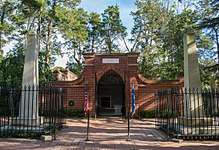

In 1831 Washington's old family vault, that he was interred in, was broken into and bones were stolen. This created an alarm among his remaining family estate. The bones, not Washington's, were returned and Washington's nephew, Major Lawrence Lewis, the same year, made the new vault Washington had requested 31 years earlier.[26] The same year Washington's coffin and remains were moved to the new Vault. The front of the new tomb consisted of a gothic iron gateway mounted on stone coping. In 1837 a sarcophagus made by John Struthers, for Washington, and his remains and the original lead casket, were placed inside, covered, and sealed on October 7, 1837. Rather than put into the damp new vault, inappropriate for public viewing, Struther's had a new structure built, specifically made for Washington, on the outside of the vault, with a marble floor, covered by a metal roof, and guarded by an iron gate. The lid of Washington's sarcophagus was inscribed "WASHINGTON".[27] A second marble sarcophagus was made for his wife Martha's remains, adjacent to Washington's sarcophagus and his remains.
Washington D.C. equestrian statue 1853-1860
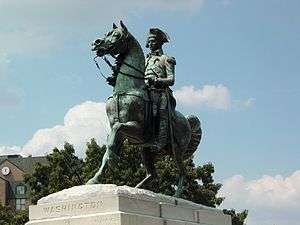
Washington Circle Park
Clark Mills
In 1853, Congress had commissioned the equestrian statue of Lieutenant General George Washington. It was created by artist Clark Mills, modeled and cast in bronze, at a cost of $50,000. The statue depicted Washington's victory at Princeton during the Revolutionary War. Mills wanted Washington to be scene personlly leading his men, as he had done at Princeton, defeating the British forces. Mills believed that Washington leading his troops ensured the victory over the British. The statue depicts Washington at the battle scene, his horse is startled, while Washington looks sternly at his British foe. The statue was formerly dedicated by President James Buchanan on February 20, 1860. The statue was placed at Washington Circle Park in Washington D.C. Mills' statue is said to be the most life like of Washington in existence.[28] One year, one month, and twenty-three days later, after its dedication, the nation that Washington created, would be plunged into a devastating Civil War.
Washington monument 1833-1885
_(cropped).jpg)
The Federal City (Washington D.C.), during Washington's lifetime, was originally designed for the place of Washington's memorial. Architect Pierre L'Enfant had specifically set apart land space for a monument to Washington, southwest of the Capital and the White House. The city was completed in 1800 and incorporated officially taking on Washington's name. After Washington's death in December 1799, Congress made no appropriations for Washington's marble monument, although it had pledged to do so. For three decades, no funding still had not been granted by Congress for Washington's memorial. This created a public outcry and upset many who believed it was time to honor the first President of the United States, and in 1833 the private Washington National Monument Society was formed. The Society solicited funding from private donors and set out to build the monument, without Congressional funding. In 1845, the Society chose Robert Mills's design, an expensive, lavish Egyptian obelisk, 600 feet tall, that would contain thirty 100-foot base columns.[29]
Work began on the monument on July 4, 1848. An 80-square-foot pyramid underground foundation was built followed by 55-feet 1.5-inch marble base. By 1854, the tower had reached 156 feet above the ground, however, due to lack of funding, further construction was stopped. Throughout the American Civil War, the memorial stood incomplete, while Congress for another decade refused to take over the project. It was not until July 5, 1876, under the Presidency of Ulysses S. Grant, that Congress finally passed a law to take over the funding and building of Washington's memorial. On December 6, 1884, a 3,300-pound capstone was placed on top of the tower, and Washington's memorial was finally complete. Although design changes took place, the finished memorial stood at 555 feet tall, ten times the width of the base, making it the tallest tower in the world. The thirty ornate 100-foot base columns were scrapped for aesthetic and cost reasons. The monument was officially dedicated on February 21, 1885.[29]
20th century
Mount Rushmore memorial 1923-1941

Granite sculpture on the front face of Mount Rushmore.
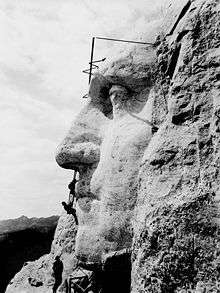
In 1923, historian Doane Robinson had developed an idea to make a gigantic sculpture on the Black Hills of South Dakota. Robinson hired renowned sculptor Gutzon Borglum for the job. Borglum, at the time, was making a Confederate memorial on Stone Mountain. Borglum searched for a mountain suitable for his project and he found Mount Rushmore, composed of granite, named after a New York attorney Charles E. Rushmore. Four prominent presidents were chosen for the sculptor to bring national recognition, including George Washington, Thomas Jefferson, Theodore Roosevelt, and Abraham Lincoln. Washington was chosen to represent a "light for liberty and the birth of the Republic." Washington was believed to upheld rights for the common citizen.[30]
The project began on August 10, 1927[lower-alpha 2] and implemented innovative blasting and drilling techniques on a large scale. Lack of funding, however, extended the memorial's creation to 14 years, but in actual time, it took 6 1/2 years of difficult and dangerous work to complete the gigantic sculptor. It took 400 men to construct the memorial, remarkably, no one was killed in the process. The surface of the stone sculpture was finished to the smooth surface of a concrete sidewalk. The project cost $989,992.32 and was finished in October 1941. $836,000 in federal funding was used while private donations made up the difference. As the first United States President, under the Constitution, Washington's portrait was the first to be sculptored on a grand scale. Honored among presidents, he was chosen to be displayed in front of the other three chosen presidents. Washington was believed to have stood for the cause of liberty during the American Revolution. Washington was held in high esteem, and believed to have stood for holding office with "dignity, prudence, and respect," and was an example for other Presidents to follow. [30]
Military vessels named after
Washington is named after many vessels during and after his lifetime.
- USS Washington (1775) Schooner
- USS Washington (1776) Galley
- USS Washington (1776) Frigate
- USS Washington (1776) Galley
- USS George Washington (1798) Frigate
- USS Washington (1814) Warship
- USS George Washington (SSBN-598) (1959) Nuclear Ballistic Missile Submarine
- USS George Washington (CVN-73) (1992) Nuclear Aircraft Carrier Active Service 2018
Notes
References
- ↑ Lillback & Newcombe 2006, pp. 1–1187.
- 1 2 3 4 Cooke 2002, p. 19.
- 1 2 3 4 Cooke 2002, pp. 19-20.
- 1 2 3 4 Ferling 2000, p. 277.
- 1 2 Flexner 1974, p. 397.
- ↑ Chernow 2010, p. 767.
- ↑ Chernow 2010, p. 769.
- 1 2 Abbot 1999.
- ↑ Chernow 2010, pp. 775-777.
- 1 2 Akers 2002, p. 27.
- ↑ Akers 2002, p. 29.
- ↑ Grizzard 2002, p. 263.
- ↑ Akers 2002, pp. 29-30.
- ↑ Ferling 2000, p. 276.
- 1 2 3 4 Smith.
- ↑ MacLeod.
- ↑ Ten Facts About Washington & Slavery.
- ↑ Ferling 2000, p. 296; Cooke 2002, p. 20.
- 1 2 Wallenborn 1999.
- ↑ Marx 1955.
- ↑ Chernow 2010, pp. 806–807; Lear 1799, p. 257.
- 1 2 3 Chernow 2010, pp. 809-810.
- 1 2 Eliassen.
- 1 2 Chernow 2010, p. 810.
- 1 2 Chernow 2010, pp. 811-812.
- ↑ Wineberger 1858, pp. 39-40.
- ↑ Wineberger 1858, pp. 41-47.
- ↑ Boston to Washington 1876, p. 230.
- 1 2 Washington Monument History & Culture 2018.
- 1 2 National Park Service Brochure 1965.
Sources
- Abbot, W. W. (December 5, 1999). "George Washington in Retirement". The Washington Papers. University of Virginia.
- Akers, Charles W. (2002). "John Adams". In Graff, Henry. The Presidents: A Reference History (7th ed.). New York City: Charles Scribner's Sons. pp. 23–38. ISBN 0-684-80551-0.
- Boston to Washington: A Complete Pocket Guide To The Great Eastern Cities And The Centennial Exhibition With Maps. Cambridge: Hurd And Houghton The Riverside Press. 1876.
- Chernow, Ron (2010). Washington: A Life. Penguin Press. ISBN 978-1-59420-266-7. , Pulitzer Prize
- Cooke, Jacob E. (2002). "George Washington". In Graff, Henry. The Presidents: A Reference History (7th ed.). New York City: Charles Scribner's Sons. pp. 1–21. ISBN 0-684-80551-0.
- Eliassen, Meredith. "Mourning George Washington". mountvernon.org. San Francisco State University: The Mount Vernon Ladies' Association.
- Ferling, John E. (2000). Setting the World Ablaze: Washington, Adams, Jefferson, and the American Revolution. New York: Oxford University Press. ISBN 0-19-513409-5.
- Flexner, James Thomas (1974). Washington: The Indispensable Man. Boston: Little, Brown. ISBN 0-316-28605-2. Archived from the original on March 12, 2017.
- Ford, Worthington Chauncey (1900). George Washington. 2. New York: C. Scribner's Sons.
- Grizzard, Frank E. (2002). George Washington: A Biographical Companion. Santa Barbara, California: ABC-CLIO. ISBN 1-57607-558-3.
- Henriques, Peter R. (2008). Realistic Visionary: A Portrait of George Washington. University of Virginia Press. pp. 194, 196.
- Lear, Tobias (1799). Tobias Lear to William Augustine Washington December 15, 1799 (The Writings of George Washington, Volume 14). G. P Putman & Sons. p. 257.
- Lillback, Peter A.; Newcombe, Jerry (2006). George Washington's Sacred Fire. ISBN 9780984765423.
- MacLeod, Jessie. "William (Billy) Lee". mountvernon.org. George Washington's Mount Vernon: The Mount Vernon Ladies' Association.
- Marx, Rudolph (August 1955). "A Medical Profile Of George Washington". American Heritage. Vol. 6 no. 5. American Heritage Publishing.
- Mooney, James L., ed. (November 1983). Dictionary of American Naval Fighting Ships. 6. Defense Dept., Navy, Naval History Division. ISBN 0-16-002030-1.
- Mount Rushmore National Memorial South Dakota (PDF). National Park Service. 1965.
- Schlossberg, David, ed. (2012). Infections of the Head and Neck. Springer Science & Business Media. p. 135.
- Smith, Craig Bruce. "Status of Slaves in Washington's Will". mountvernon.org. Brandeis University: The Mount Vernon Ladies' Association.
- "Ten Facts About Washington & Slavery". mountvernon.org. The Mount Vernon Ladies' Association.
- Wallenborn, White McKenzie, M.D. (1999). "George Washington's Terminal Illness: A Modern Medical Analysis of the Last Illness and Death of George Washington". The Papers of George Washington. University of Virginia.
- "Washington Monument History & Culture". April 16, 2018.
- Wineberger, James Albert (1858). The tomb of Washington at Mount Vernon Embracing a full and accurate description of Mount Vernon, as well as of the birthplace, genealogy, character, marriage, and last illness of Washington. Washington, T. McGill.